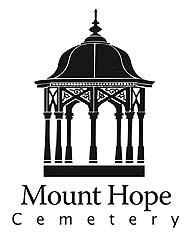In collaboration with The Friends of Mt. Hope Cemetery, Studio X, and the Humanities Center, Experiencing Civic Life students captured 360 degree photos of a select set of monuments and memorials in Mt. Hope Cemetery. Aiming to create an informative, virtual experience of Mt. Hope, our students produced brief reports about the monuments as well as the people they commemorate.
Ezra Andrews (1828 – 1900)
By: RaeVonna Houser
One of Rochester’s foremost community leaders of the 19th century was Ezra Andrews. He was born March 16, 1828. He co-owned Rochester’s Democrat newspaper. He died August 13, 1900.
William B. Morse (1824 – 1904) and Frances Case Morse (1841 – 1933)
By: Willem Oliveiri
This is the grave site of the Morse family within the Mt. Hope cemetery. The Morse family made many contributions to the city of Rochester. William B. Morse was very passionate about his family and his lumber business. He made many contributions to the lumber industry of Rochester, which continues to this day run by his great grandchildren.
Frances Case Morse was the wife of William B. Morse and made many contributions towards the city of Rochester. She was a friend and a neighbor of Susan B. Anthony, and she supported the women’s suffrage movement.
George Baldwin Seldon (1846 – 1922)
By: Josiah Brown
George Baldwin Seldon was born in Clarkson NY and attended the University of Rochester. His father was a republican attorney who was most known for defending Susan B. Anthony. George dropped out of school early to join the Union Army, but his father convinced him to leave the military and enroll at Yale to study law. After school he practiced law and pursued work as an inventor. He is best known for establishing a patent for the first automobile.
Chester Dewey (1784 – 1867)
By: Jhy’Asia Jackson
Chester Dewey was born in Massachusetts 1784 and died in 1867. He erected a school which later became School 58/World Of Inquiry.
Leonard Henkle (1834 – 1904)
By: Ariane Cisse
Leonard Henkle was originally from Ohio. He lived several years with the Sioux, a people he cared about. He later joined the Civil War as a musician. He eventually moved to Rochester and became an inventor. One of his well known inventions was called “The rochester lamp.”
M. Louise Stowell (1861 – 1930)
By: Infinity Hernandez
M. Louise Stowell was an amazing artist who also specialized in water painting.Louise was born January 1st 1861 at Hornell, NY but moved to Rochester with her family when she was a baby. Louise was the daughter of Thomas P. Stowell, who was a mathematician and an insurance adjuster, and her mother, Henrietta Fowler. Stowell was a child of 5.
M. Louise Stowell went to The Art Students League of New York. Louise helped shape Rochesters Art club. Louise taught at what’s now known as R.I.T. Louise inspired artists all around the world and even was the only female to win a prize in a German poster contest which gained her international admirers. Louise had a huge impact on the economy of Rochester’s art culture.Louise influenced Ellis (a fellow student of hers when she was in art school) who took on a similar art style as Louise even though others thought he influenced her. M. Louise Stowell sadly stopped making art in 1909 and started running an imported goods shop till she died in February 1930. M. Louise Stowells brilliance will forever live through her art.Thank you for helping to open eyes to the world of art.
George Clarkson (1811 – 1905)
By: Tiketa Thomas
An immigrant from Edinburgh, Scotland, George Clarkson served as the 39th Mayor of Rochester, New York. He was known for actively seeking out the deaf community to see how he could provide a better environment for their students. He took the initiative to start a series of conversations about the quality of care that deaf children were receiving. His efforts led to the foundation of Rochester’s School for the Deaf.
Fletcher Steele (1885 – 1971)
By: Ciara Jones
Fletcher Steele was born in Rochester on June 7th, 1885 and passed at the ripe old age of 86 on July 16th, 1971. Steele was an architect and went to Harvard for graduate school. Starting from 1915 he built over 700 gardens. He wanted to build from the moment his mother commented on a pretty site in Turk Hill. She described how beautiful it was and from that very moment he wanted to build things for people so that they could also see things that are beautiful.
Margaret Woodbury Strong (1897 – 1969)
By: Syd Ferree
Margaret Strong was an eccentric collector born to a wealthy family living in Rochester. She collected a great many items throughout her life including toys, magazines, buttons, doorknobs, lamps, artwork, model ships, furniture, clothing, coins, stamps, and the list goes on. Her collection is varied in its scope and large in size, containing more than 300,000 items.
She showed interest as a young child in collecting toys, something that only grew with age as she accompanied her parents on trips overseas. By the time of her death, her collection of dolls numbered 22,000, and her collection of bookplates 84,000. In 1968 she created a state charter that would turn her estate into the Margaret Woodbury Strong Museum of Fascination, and provided 100,000,000 dollars for its construction. It was started in 1973 and was not finished until 1982. Her massive collection of toys and other objects provides not only a source of amusement for Rochester, but a source of education and information about things made in the past.
Zebulon Hebard (1793 – 1852)
By: David Buyon
Zebulon Hebard was born August 1, 1793 and died February 23, 1852. Hebard founded “Hebard’s Steam Marble Works” on south St Paul. The masonry is the oldest stone business in Western NY.
Henry B. Rundel (1844 – 1886)
By: Paola Ebumbu

